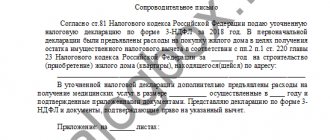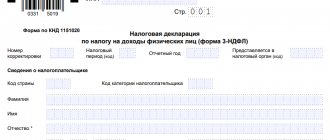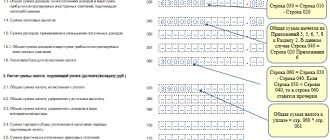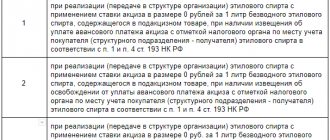Situations with incorrect reflection of kopecks in accounting and reporting can lead to a large number of unfavorable consequences, for example, tax authorities may refuse to accept reports, as well as make a claim for a “penny” amount. Arrears may prevent you from obtaining a certificate of no debt to the budget. If prices and costs in invoices are rounded, auditors may refuse to deduct VAT to the counterparty.
At the same time, there are several options for rounding in accordance with current legislation: it is possible to round amounts to whole rubles, but it is not advisable in primary documents; rounding cannot be done in invoices and when calculating insurance premiums; amounts must be rounded in declarations; this is required by law. In general, it turns out that an accountant needs to remember and always keep these rules in mind, which are easy to get confused about. Let's look at each of the options, drawing up a reminder of when it is possible, impossible and necessary to round pennies to the ruble.
Invoices
In invoices, rounding kopecks to whole rubles is not allowed. Papers are filled out in rubles and kopecks (letter of the Ministry of Finance of Russia dated January 29, 2014 No. 03-02-07/1/3444). The rules for issuing an invoice used in VAT calculations (approved by Decree of the Government of the Russian Federation dated December 26, 2011 No. 1137) in paragraph 3 indicate that all cost indicators are reflected in rubles and kopecks (US dollars and cents, euros and eurocents or in another currency).
If in the documents the organization indicates amounts in kopecks, but in the “primary” form in rubles, the company may encounter situations that will serve as a reason for the tax authority to refuse to deduct input VAT to the buyer. Conclusion: in all documents it is better to reflect the indicators in kopecks!
Since contributions are calculated in rubles and kopecks, and when paid, their amount is rounded up, arrears may arise, for example, 1,500 rubles were accrued. 42 kopecks, and 1500 rubles were paid. Such arrears do not entail liability for the organization, provided that insurance premiums are paid on time...
The buyer may have doubts about the rounding of amounts; discrepancies will be insignificant, but their presence may become a reason for business partners to constantly contact them to make corrections to the documents.
What solution is offered in this case? Add an additional clause to your accounting policy with the following wording: “Employees prepare primary documents and invoices in an accounting program. The program automatically rounds the total cost of goods to two decimal places. When calculating the final cost, the program takes VAT without rounding. In this regard, small discrepancies (up to five kopecks) between the data in the program and the amounts calculated manually are possible.”
An extract from the accounting policy presented to customers will allow you to avoid frequent corrections in primary documents.
The procedure for rounding VAT in invoices
You cannot round the tax, but you cannot do without it if there are more than two digits after the decimal point.
The general rule is to round taxes to two decimal places. If discrepancies arise because of this, they are not considered errors even by the tax authorities and do not require correction. But more accurate calculations indicating three or four decimal places are also not prohibited by law. Therefore, this procedure is not a violation if it helps to indicate the exact amounts.
At the same time, due to rounding, the buyer may have difficulty reflecting data in the accounting program. To prevent this from happening, some companies round all indicators up to four digits. This can also be done, but it is not necessary.
Cash balance limit
The cash balance limit at the cash desk can be rounded up or down to the full ruble. On June 1, 2014, Bank of Russia Directive No. 3210-U dated March 11, 2014 came into force. This document replaced Bank of Russia Regulation No. 373-P dated October 12, 2011, which is no longer in effect. A legal entity independently determines the cash balance limit in accordance with the appendix to this Directive, based on the nature of the activity, taking into account the volume of receipts or the amount of cash issued. Individual entrepreneurs and small businesses may not set a cash balance limit.
The cash limit at the cash desk can be rounded to whole rubles according to the rules of mathematics. This was confirmed by officials (letter of the Federal Tax Service of Russia dated March 6, 2014 No. ED-4-2/4116). And primary cash documents, for example, expense orders, must be filled out with pennies.
The inspectors' view of VAT payment
If you follow the explanations of the Ministry of Finance, it may seem that agency VAT must be paid to the budget:
- in full rubles - if the tax is paid based on the results of the declaration.
This is, for example, payment of agency VAT when renting state or municipal property;
- in rubles and kopecks - if the tax is paid not based on the results of the declaration, but for each transaction. For example, when paying money to a foreign contractor for services purchased from him.
But it turns out that everything is a little different.
Taxes and fees
First of all, it is necessary to separate the concepts: taxes and fees, since regulatory regulation on these issues is established by different legislative acts. In the words of experts, a tax in a real tax mechanism is an irrevocable and urgent form of forced collection from taxpayers in accordance with the tax code of a part of their income in order to satisfy socially necessary needs, and the fee is a targeted contribution aimed at covering state expenses.
VAT calculator
Articles: About filling out prices excluding VAT, costs excluding VAT, VAT amounts in invoices using 1C programs. This article discusses the issue of correctly filling out the tabular part of an invoice using the 1C program.
Attention
The reason for the study was the question of whether there is an error in the invoice created on the basis of a document for the sale of goods (works, services), in which in the 1C program the costs of goods are specified including VAT. For example, in the invoice shown in the illustration, 13 units of goods were sold at a price of 1,500 rubles: In this case, the product of the quantity of goods and the price does not coincide with the cost of the goods excluding VAT: 97.78 * 13 = 1271.14 < 1271.19 All considered examples relate to the sale of goods, but they are fully applicable to the sale of works, services and property rights.
Declarations and payment orders
In tax returns and payments, amounts are indicated in whole rubles.
Paragraph 6 of Article 52 of the Tax Code establishes the main rule for calculating taxes: their amount must be reflected in full rubles. The Ministry of Finance in letter dated March 5, 2014 No. 03-07-15/9519 explained that this article of the code regulates the procedure for calculating the amounts of taxes payable to the budget, which are reflected in declarations.
Rounding to whole rubles is not allowed in invoices. The legislation obliges companies to fill out these documents in rubles and kopecks.
The amount is calculated in full rubles: what is less than 50 kopecks is discarded, what is more is rounded up, says the well-known rule, which is enshrined in Article 52 of the Tax Code. However, there are exceptions to this rule that should not be forgotten. In the form of any declaration, you can see that not only the final data is rounded, but also the intermediate figures on each sheet. Therefore, if the amount of tax that the accountant reflects in the declaration, he also indicates in the payment order, there will be no discrepancies.
Problems with the tax authorities
In invoices, all costs must be indicated in rubles and kopecks. But some suppliers, due to errors or inexperience, round up the total, thereby inflating the VAT amount.
As a result, the buyer's tax deduction is overestimated. The difference will be in kopecks, but because of this, inspectors may refuse not only the difference, but even a VAT deduction in general. Therefore, resolve these issues with your counterparties in advance, and if documents are completed incorrectly, demand corrections.
Example. The company shipped 60 boxes of pineapples. Price for 1 box—RUB 1,527.36. Correct calculation. Indicate on the invoice:
If the supplier rounds the amount including VAT to 109,970 rubles, then the VAT will be overestimated, and the buyer may lose the deduction.
There are many problems and questions with VAT calculation, but the Kontur.Accounting web service will help you cope with most of them. The system automatically rounds up VAT in the manner prescribed by law. And tax returns can be submitted online. All new users receive 14 days of using the service as a gift.
On the website https://www.buhotvet.ru in the section “Presenting VAT amounts for payment to the buyer, invoices” - I found a lot of interesting and useful information about invoices, I learned a lot of useful information, but I did not find an answer to my question — (I read up to the 30th page!!! and didn’t find it) In general, on the internet I came across 3 ways to solve this problem: 1) THE MOST IDEAL AND MOST UNREALISTIC: bring all prices at the enterprise to such a form that VAT is calculated penny per penny, without tenths of a kopeck, whereas no matter how you count the VAT - forward or backward, from right to left or from left to right - everything will always add up!!! But this is unrealistic. 2) “cheat” with the invoice and manually adjust the VAT amount in some cell of the invoice - then the total amount in the VAT column will converge with the back-calculated VAT amount. But it seems to me that this is also not correct, because... again, the check may find fault that VAT was calculated incorrectly in this cell, and recognize the registration of this account as INCORRECT. 3) some enterprises went this way - they tweaked the program and used 3 decimal places in the VAT column - which also raises doubts, because You can’t fit 3 decimal places into an accounting entry; according to the law, we record in rubles and kopecks, and not in fractions of kopecks. I scoured the Internet and already came across my same question 20 times, formulated by other people, but, unfortunately, in the answers to these questions no one referred to an official explanation or at least an article in some accounting journal. It seems that everyone is trying to get out of this situation as best they can. Most probably CUSTOMIZE the invoice. Well, then, there is NO legal way out of this situation?
Insurance premiums
Insurance contributions for compulsory pension, medical and social insurance in case of temporary disability and in connection with maternity are charged for each employee separately (Part 6, Article 15 of the Federal Law of July 24, 2009 No. 212-FZ). In this case, the amount of any of these types of contributions, payable for the organization as a whole, is determined in full rubles (Part 7, Article 15 of Law No. 212-FZ). Thus, an amount of less than 50 kopecks is discarded, and an amount of 50 kopecks or more is rounded up to the full ruble. Thus, the specified insurance contributions to the Pension Fund of the Russian Federation, the Social Insurance Fund and the Federal Compulsory Medical Insurance Fund must be calculated in kopecks, but paid in full rubles. Information on accrued and paid contributions is reflected in the corresponding calculations (Part 9, Article 15 of Law No. 212-FZ).
Since contributions are calculated in rubles and kopecks, and when paid, their amount is rounded up, arrears may arise (for example, 1,500 rubles 42 kopecks were accrued, but 1,500 rubles were paid in accordance with the rounding rules). Please note that such arrears arising as a result of the application of rounding rules do not entail liability for the organization, provided that insurance premiums are transferred on time (letter of the Ministry of Labor of Russia dated February 14, 2013 No. 17-4/264).
In another situation, if the organization does not follow the rounding rules, arrears are also possible (for example, 1500 rubles 76 kopecks were paid instead of 1501 rubles). In these cases, claims by officials and demands for payment of arrears, penalties and fines are possible (Article 22 of Law No. 212-FZ).
As for insurance contributions for compulsory social insurance against industrial accidents and occupational diseases, the procedure for their payment is regulated by Federal Law No. 125-FZ of July 24, 1998. This law does not contain requirements to round up the amounts of contributions when paying. Thus, in contrast to contributions for compulsory pension, medical and social insurance in case of temporary disability and in connection with maternity, contributions for “injuries” are paid in rubles and kopecks.
Insurance premiums can also be paid in whole rubles (clause 7, article 15 of the Federal Law of July 24, 2009 No. 212-FZ). But if amounts are rounded in tax returns, then insurance premiums are not reported in reporting. Indicators in forms RSV-1 PFR and 4-FSS are indicated in rubles and kopecks. Therefore, small discrepancies may arise between the data in the reporting and in the payments.
Tatiana Lesina
, accountant, for the magazine "Calculation"
Guide for the simplified tax system
With this e-book, you will easily understand all the intricacies of the simplified taxation system, competently draw up a balance sheet and financial statements. You will receive the electronic edition immediately after payment to your email. Find out more about the publication >>
If you have a question, ask it here >>
Tax agent: pay VAT with or without kopecks
The article from the magazine “MAIN BOOK” is current as of November 10, 2017.
Contents of magazine No. 22 for 2021 TAX AGENTL.A. Elina, leading expert When an organization acts as a tax agent for VAT, it must withhold this tax from the taxpayer’s income and transfer it to the budget. Sometimes the calculated VAT amount is not in full rubles, but in rubles and kopecks. Is it necessary to round up VAT to full rubles when deducting? What about paying to the budget? It turns out that these similar questions have different answers.
The topic of the article was suggested by Deputy Chief Accountant of School World LLC Maria Demasheva, Moscow
Where do the “agency” pennies come from?
The Tax Code instructs the agent:
•calculate VAT at the established rate and draw up an invoice. 1-3 tbsp. 161 Tax Code of the Russian Federation;
•withhold this amount from the taxpayer's income;
•pay tax to the budget.
In invoices and in the sales book, the calculated tax is indicated in rubles and kopecks. 3 Rules for filling out an invoice, approved. Government Decree No. 1137 dated December 26, 2011 (hereinafter referred to as Decree No. 1137); Letter of the Ministry of Finance dated April 22, 2014 No. 03-07-07/18585.
But taxes must be paid to the budget in full rubles. 6 tbsp. 52 of the Tax Code of the Russian Federation. However, according to the explanations of the Ministry of Finance, this rule applies only to VAT amounts payable based on the results of the declaration. Letter of the Federal Tax Service dated 04/07/2014 No. GD-4-3 / [email protected] (together with the Letter of the Ministry of Finance dated 03/05/2014 No. 03-07-15 /9519).
As a result, some tax agents pay tax in full rubles, others in rubles and kopecks. And during the reconciliation, it may turn out that you and your inspection have different views on whether it is necessary to round up agency VAT when paying.
The inspectors' view of VAT payment
•in full rubles - if the tax is paid based on the results of the declaration. This is, for example, payment of agency VAT when renting state or municipal property;
•in rubles and kopecks - if the tax is paid not based on the results of the declaration, but for each transaction. For example, when paying money to a foreign contractor for services purchased from him.
But it turns out that everything is a little different.
Payment of VAT by a tax agent
| DUMINSKAYA Olga Sergeevna Advisor to the State Civil Service of the Russian Federation, 2nd class |
— When calculating the amount of VAT, the tax agent must draw up an invoice. 3 tbsp. 168, paragraphs. 5, 6 tbsp. 169 of the Tax Code of the Russian Federation.
When drawing up an invoice, cost indicators in columns 4-6, 8 and 9 must be indicated in rubles and kopecks. 3 Rules for filling out an invoice, approved. Resolution No. 1137. Such an invoice is registered in the sales book, which is also kept in rubles and kopecks - without any rounding. 9, 15 Rules for maintaining a sales book, approved. Resolution No. 1137.
Taking into account the above, the tax agent must withhold from the taxpayer’s income the amount of VAT in rubles and kopecks. But the amount of tax payable to the budget is calculated in full rubles: the tax amount is less than 50 kopecks. is discarded, and the tax amount is 50 kopecks. and more is rounded to the full ruble. 6 tbsp. 52 of the Tax Code of the Russian Federation.
Thus, the amount of VAT payable to the budget by the tax agent both during a specific tax period (for example, for the services of foreign companies) and for a specific tax period (for example, when renting state and municipal property) is reflected on line 060 Section 2 of the VAT return in full rubles. Such amounts are also transferred by the tax agent in full rubles.
As you can see, it’s all about the peculiarities of filling out the VAT return.
Tax officials transfer to personal accounts exactly the amounts of taxes indicated in the declarations. So, when paying agent VAT in full rubles, there will be no discrepancies between the data specified in the declaration and the amount received from you. That is, there will be no arrears or overpayments.
If you pay the exact amount including kopecks, the following may occur:
•or a small overpayment (from 1 to 49 kopecks);
•or a small underpayment (from 1 to 50 kopecks). In this case, you may be charged a penalty. 7 tbsp. 75 of the Tax Code of the Russian Federation. Considering that the amount of arrears is meager, the amount of penalties will also be small.
How to claim VAT for deduction
After payment, agency VAT can be deducted if the agent is himself a taxpayer, and the work or services are used in activities subject to VAT. 3 tbsp. 171 Tax Code of the Russian Federation.
How to claim an agent VAT deduction if it is calculated and, accordingly, indicated in the invoice with kopecks? But at the same time, paid to the budget in whole rubles? Here are the explanations given by a tax specialist on this matter.
Agent VAT deduction
— After paying VAT to the budget, the tax agent can register the invoice in the purchase book. In this case, VAT amounts must be indicated in rubles and kopecks. 8 Rules for maintaining a purchase book, approved. Resolution No. 1137. However, deduction is possible only for the amount of VAT that was paid to the budget. It is this amount, expressed in full rubles, that will be reflected on line 180 of section 3 of the VAT return.
For example, VAT when paying for services of a foreign organization is withheld in the amount of 5,689 rubles. 49 kopecks It is this amount that must be reflected in the invoice, which must be drawn up by the tax agent. You must pay 5,689 rubles to the budget. And this same amount must also be shown on line 060 “Tax amount” of section 2 of the VAT return.
In the sales book, the invoice is recorded in rubles and kopecks. In the purchase book, the tax agent (if the conditions for VAT deduction are met) also registers such an invoice in rubles and kopecks. That is, the tax amount will be indicated in the purchase book as 5689.49 rubles.
However, VAT deduction will be provided only for the amount paid to the budget, that is, without taking into account kopecks. Indeed, in section 3 of the VAT return, all amounts are indicated in full rubles.
If during one tax period (quarter) the tax agent withheld VAT on several transactions, due to rounding, insignificant discrepancies between the purchase book/sales book and the declaration are possible. There is no need to be afraid of this. There should be no problems with the desk verification of the declaration.
* * *
In accounting, the amount of discrepancies due to tax rounding when paying and filling out a declaration can (for example, at the end of the year) be attributed to financial results. 25 Regulations, approved. By Order of the Ministry of Finance dated July 29, 1998 No. 34n; Letter of the Federal Tax Service for Moscow dated January 28, 2005 No. 21-11/5447. That is, these amounts can be written off from account 68 (sub-account “Calculations with the budget for VAT”) either to the debit of account 91-2, or to the credit of account 91-1.








